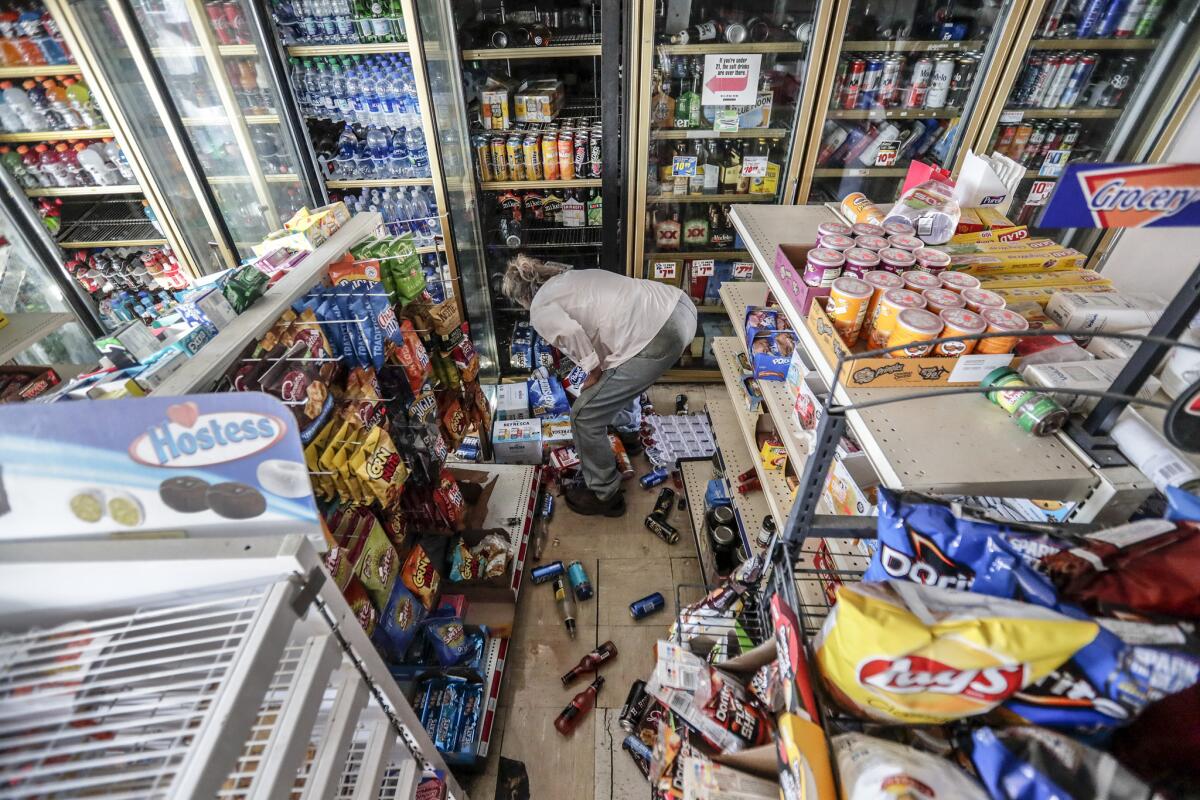Your instinct may be to run outside during an earthquake. Here’s why you shouldn’t

- Share via
When two big earthquakes struck Ridgecrest, Calif., in the span of two days, several residents said they ran outside, looking for solace — and presumed safety — in open spaces.
But experts have long warned the public against leaving a building and heading outdoors during a quake. The safest place to be as the earth moves is inside, protected from potentially crushing debris, drooping power lines, falling trees or building extremities that could crumble.
Last week’s earthquakes — a magnitude 6.4 temblor on July Fourth followed by a 7.1 quake the following night — left a crack in the foundation of neighboring Trona. But in the Searles Valley area, disaster was largely avoided, thanks to a sparse population. A similar quake in the densely populated Los Angeles basin, however, would have brought about far more damage.
In 2016, seismologist Lucy Jones explained experts’ reasoning for staying inside in the event of an earthquake.
Why not just run from a building during an earthquake?
Because, says Jones, “the first thing to fail in a building is the outside, so you have balconies falling off and facades falling off. You’re putting yourself into a more dangerous situation by moving to the outside of a building.”
Even if the outside edges of a building collapse, the building can largely remain standing.
FULL COVERAGE: Two major quakes hit Southern California in two days »
This happened during the Paso Robles earthquake of 2003: Two women working at a clothing store were crushed to death by falling bricks and plaster as they ran out of an old, quake-vulnerable brick building.
Had they stayed inside, it was determined, they probably would have survived.
During the deadly earthquake in Christchurch, New Zealand, in 2011, one man faced a split-second decision between fleeing outside and dropping under a table. He chose to drop and cover under a table and survived. He later said that had he chosen to flee, he would have been crushed by falling debris.
But what if a building is collapsing?
There’s not much evidence that trying to flee is a better idea, Jones said. When a collapse happens, it can happen so quickly there’s only time to drop and cover.
Even when buildings do collapse, search-and-rescue teams combing through the wreckage in places like Haiti have found survivors who were found underneath spaces like tables.
“They found people under desks that dropped and covered in place, and they could come and dig them out. There’s a lot of evidence that it can save you,” Jones said.
What has happened when people have tried to run in past earthquakes?
“We have numerous cases of people dying trying to run out of the building,” Jones said. Consider the 1987 Whittier Narrows earthquake, which was a magnitude 5.1.
Among the three people whose deaths were directly caused by the earthquake, one was believed to have jumped from the window of his apartment and died from the impact of the fall. Another was a Cal State Los Angeles student who was fleeing a three-story parking structure and was crushed by falling concrete. Neither the apartment nor the parking structure suffered a total collapse, Jones said.
For more tips on how to protect yourself during an earthquake, visit this resource page.
Times staff writer Colleen Shalby contributed to this report.
More to Read
Sign up for Essential California
The most important California stories and recommendations in your inbox every morning.
You may occasionally receive promotional content from the Los Angeles Times.











